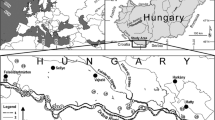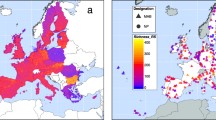Abstract
The recent increase in the number of monitoring schemes has formed the basis for high quality distribution atlases. This provides the opportunity of estimating global and specific decline patterns across regional and national borders. In this framework, this study focused on four sympatric newt species—including the great crested newt (Triturus cristatus), an Annex 2 European Habitats Directive species, over six geographic areas (five countries) in Western Europe. A relative comparison of distribution maps across time is used here and is based on more than twelve thousands occupied grid cells. It benefits from the definition of a guild, as these species are simultaneously detectable in wetlands. T. cristatus and the alpine newt (Mesotriton alpestris) were the most and the least threatened newt species, respectively, whereas the palmate (Lissotriton helveticus) and smooth newt (Lissotriton vulgaris) had an intermediate decline level at both coarse and fine grain resolutions. However, regional variations across Europe and scale effects were also found. On one hand, these results show that T. cristatus is not only regionally threatened but suffers from a global decline in Western Europe. On another hand, the results indicate that patterns of decline are not uniform within Europe and that species often considered as common and not threatened are, in fact, declining more than others. Finally, the proposed methodology, i.e. using guilds to assess relative decline, would be useful as a complement to other standardized methods in correctly advising conservation managers and policy makers, particularly for species with more subtle declines.


Similar content being viewed by others
References
Amori G, Gippoliti S, Luiselli L (2011) Do biodiversity hotspots match with rodent conservation hotspots? Biodivers Conserv 20:3693–3700
Araujo MB, Nogues-Bravo D, Reginster I, Rounsevell M, Whittaker RJ (2008) Exposure of European biodiversity to changes in human-induced pressures. Environ Sci Pol 11:38–45
Balmford A, Bond W (2005) Trends in the state of nature and their implications for human well-being. Ecol Lett 8:1218–1234
Böhning-Gaese K (1997) Determinants of avian species richness at different spatial scales. J Biogeogr 24:49–60
Bonardi A, Manenti R, Corbetta A, Ferri V, Fiacchini D, Giovine G, Macchi S, Romanazzi E, Soccini C, Bottoni L, Padoa-Schioppa E, Ficetola GF (2011) Usefulness of volunteer data to measure the large scale decline of “common” toad populations. Biol Conserv 144:2328–2334
Brotons L, Herrando S, Pla M (2007) Updating bird species distribution at large spatial scales: applications of habitat modelling to data from long-term monitoring programs. Divers Distrib 13:276–288
Butchart SHM, Bird JP (2010) Data deficient birds on the IUCN red list: what don’t we know and why does it matter? Biol Conserv 143:239–247
Cadotte MW, Davies TJ (2010) Rarest of the rare: advances in combining evolutionary distinctiveness and scarcity to inform conservation at biogeographical scales. Divers Distrib 16:376–385
Creemers RCM, Van delft JJCW (2009) De amfibieën en reptielen van Nederland. Nationaal Natuurhistorisch Museum Naturalis, Leiden
de Gramont PC, Cuarόn AD (2006) An evaluation of threatened species categorization systems used on the American continent. Conserv Biol 20:14–27
Denoël M (2007) Le Triton palmé, Triturus helveticus (Razoumowski, 1789). In: Jacob JP et al (eds) Amphibiens et reptiles de Wallonie. Aves-Raînne & Région wallonne, Namur, pp 86–95
Denoël M, Ficetola GF (2007) Landscape level thresholds and newt conservation. Ecol Appl 17:302–309
Denoël M, Ficetola GF (2008) Conservation of newt guilds in an agricultural landscape of Belgium: the importance of aquatic and terrestrial habitats. Aquat Conserv-Mar Freshw Ecosyst 18:714–728
Denoël M, Lehmann A (2006) Multi-scale effect of landscape processes and habitat quality on newt abundance: implications for conservation. Biol Conserv 130:495–504
Denoël M, Džukić G, Kalezić ML (2005) Effect of widespread fish introductions on paedomorphic newts in Europe. Conserv Biol 19:162–170
Denoël M, Ficetola GF, Ćirović R, Radović D, Džukić G, Kalezić ML, Vukov TD (2009) A multi-scale approach to facultative paedomorphosis of European newts in the Montenegrin karst: distribution pattern, environmental variables and conservation. Biol Conserv 142:509–517
Donald PF, Fuller RJ (1998) Ornithological atlas data: a review of uses and limitations. Bird Study 45:129–145
Dunn AM, Weston MA (2008) A review of terrestrial bird atlases of the world and their application. Emu 108:42–67
Eaton MA, Gregory RD, Noble DG, Robinson JA, Hughes J, Procter D, Brown AF, Gibbons DW (2005) Regional IUCN red listing: the process as applied to birds in the United Kingdom. Conserv Biol 19:1557–1570
Edgar PW, Bird DR (2005) Action plan for the conservation of the great crested newt Triturus cristatus species complex in Europe. Council of Europe, Strasbourg
EEA (2010) The European environment—state and outlook 2010: synthesis. European Environment Agency, Copenhagen
Ficetola GF, Scali S, Denoël M, Montanaro G, Vukov TD, Zuffi MAL, Padoa-Schioppa E (2010) Ecogeographical variation of body size in amphibians: comparing the hypotheses using the newt Triturus carnifex. Glob Ecol Biogeogr 19:485–495
Gasc J-P, Cabella A, Crnobrnja-Isailovic J, Dolmen D, Grossenbacher K, Haffner P, Lescure J, Martens H, Martinez Rica JP, Maurin H, Oliveira ME, Sofianidou TS, Veith M, Zuiderwijk A (1997) Atlas of amphibians and reptiles in Europe. Societas Europaea Herpetologica, Muséum National d’Histoire Naturelle, Paris
Gaston KJ (2010) Valuing common species. Science 327:154–155
Gent T (2001) The conservation of the great crested newt Triturus cristatus in the UK. Rana 4:295–305
Gregory RD, van Strien A, Vorisek P, Meyling AWG, Noble DG, Foppen RPB, Gibbens DW (2005) Developing indicators for European birds. Philos Trans R Soc Lond Ser B-Biol Sci 360:269–288
Hachtel M, Schlüpmann M, Weddeling K, Thiesmeier B, Geiger A, Willigalla C (2011) Handbuch der Amphibien und Reptilien Nordrhein-Westfalens, Band 1. Laurenti Verlag, Bielefeld
Hartel T, Nemes S, Ollerer K, Cogalniceanu D, Moga C, Arntzen JW (2010a) Using connectivity metrics and niche modelling to explore the occurrence of the northern crested newt Triturus cristatus (Amphibia, Caudata) in a traditionally managed landscape. Environ Conserv 37:195–200
Hartel T, Schweiger O, Öllerer K, Cogalniceanu D, Arntzen JW (2010b) Amphibian distribution in a traditionally managed rural landscape of Eastern Europe: probing the effect of landscape composition. Biol Conserv 143:1118–1124
IUCN (2001) IUCN red list categories and criteria: version 3.1. IUCN species survival commission. IUCN, Gland
Jacob JP (2007) Liste rouge. In: Jacob JP et al (eds) Amphibiens et reptiles de Wallonie. Aves-Raînne & Région wallonne, Namur, pp 331–340
Jacob JP, Percsy C, De Wavrin H, Graitson E, Kinet T, Denoël M, Paquay M, Percsy N, Remacle A (eds) (2007) Amphibiens et reptiles de Wallonie. Aves-Raînne & Région wallonne, Namur
Jehle R, Thiesmeier B, Foster J (2011) The crested newt. A dwilling pond-dweller. Laurenti-Verlag, Bielefeld
Joly P, Giacoma C (1992) Limitation of similarity and feeding habits in three syntopic species of newts (Triturus, Amphibia). Ecography 15:401–411
Joly P, Miaud C, Lehmann A, Grolet O (2001) Habitat matrix effects on pond occupancy in newts. Conserv Biol 15:239–248
Karlsson T, Betzholtz PE, Malmgren JC (2007) Estimating viability and sensitivity of the great crested newt Triturus cristatus at a regional scale. Web Ecol 7:63–76
Koleff P, Gaston KJ (2002) The relationships between local and regional species richness and spatial turnover. Glob Ecol Biogeogr 11:363–375
Laufer H, Fritz K, Sowig P (2007) Die Amphibien und Reptilien Baden-Württembergs. Eugen Ulmer KG, Stuttgart
Lengyel S, Kobler A, Kutnar L, Framstad E, Henry PY, Babij V, Gruber B, Schmeller D, Henle K (2008) A review and a framework for the integration of biodiversity monitoring at the habitat level. Biodivers Conserv 17:3341–3356
Mace GM, Collar NJ, Gaston KJ, Hilton-Taylor C, Akcakaya HR, Leader-Williams N, Milner-Gulland EJ, Stuart SN (2008) Quantification of extinction risk: IUCN’s system for classifying threatened species. Conserv Biol 22:1424–1442
Maletzky A, Kyek M, Goldschmid A (2007) Monitoring status, habitat features and amphibian species richness of crested newt (Triturus cristatus superspecies) ponds at the edge of the species range (Salzburg, Austria). Ann Limnol: Int J Limnol 43:107–115
Mattfeldt SD, Bailey LL, Grant EHC (2009) Monitoring multiple species: estimating state variables and exploring the efficacy of a monitoring program. Biol Conserv 142:720–737
Meyer A, Zumbach S, Schmidt B, Monney J-C (2009) Les amphibiens et les reptiles de Suisse. Haupt Verlag, Bern
Mittermeier RA, Gil PR, Hoffmann M, Pilgrim J, Brooks T, Mittermeier CG, Lamoreux J, Da Fonseca GAB (eds) (2004) Hotspots revisited. CEMEX
Mucher CA, Hennekens SM, Bunce RGH, Schaminee JHJ, Schaepman ME (2009) Modelling the spatial distribution of Natura 2000 habitats across Europe. Landsc Urban Plan 92:148–159
Naidoo R, Balmford A, Ferraro PJ, Polasky S, Ricketts TH, Rouget M (2006) Integrating economic costs into conservation planning. Trends Ecol Evol 21:682–687
Parent GH (1984) Atlas des batraciens et reptiles de Belgique. Cah Ethol Appl 4:1–195
Pautasso M, Böhning-Gaese K, Clergeau P, Cueto VR, Dinetti M, Fernández-Juricic E, Kaisanlahti-Jokimäki ML, Jokimäki J, McKinney ML, Sodhi NS, Storch D, Tomialojc L, Weisberg PJ, Woinarski J, Fuller RA, Cantarello E (2011) Global macroecology of bird assemblages in urbanized and semi-natural ecosystems. Glob Ecol Biogeogr 20:426–436
Pomeroy D, Tushabe H, Cowser R (2008) Bird atlases—how useful are they for conservation? Bird Conserv Int 18:S211–S222
Proess R (ed) (2003) Verbreitungsatlas der Amphibien des Grossherzogtums Luxembourg. Musée National d’Histoire Naturelle du Luxembourg, Luxembourg
Quayle JF, Ramsay LR (2005) Conservation status as a biodiversity trend indicator: recommendations from a decade of listing species at risk in British Columbia. Conserv Biol 19:1306–1311
Rahbek C (2005) The role of spatial scale and the perception of large-scale species-richness patterns. Ecol Lett 8:224–239
Rannap R, Lohmus A, Briggs L (2009a) Niche position, but not niche breadth, differs in two coexisting amphibians having contrasting trends in Europe. Divers Distrib 15:692–700
Rannap R, Lohmus A, Briggs L (2009b) Restoring ponds for amphibians: a success story. Hydrobiologia 634:87–95
Redford KH, Coppolillo P, Sanderson EW, Da Fonseca GAB, Dinerstein E, Groves C, Mace G, Maginnis S, Mittermeier RA, Noss R, Olson D, Robinson JG, Vedder A, Wright M (2003) Mapping the conservation landscape. Conserv Biol 17:116–131
Robertson MP, Cumming GS, Erasmus BFN (2010) Getting the most out of atlas data. Divers Distrib 16:363–375
SEH (2009) Report of the mapping committee. Amphibia-Reptilia 30:299–300
Sillero N, Celaya L, Martín-Alfageme S (2005) Using geographic information system (GIS) to make an atlas: a proposal to collect, store, map and analyse chronological data for herpetofauna. Rev Esp Herp 19:87–101
Soberon J, Peterson AT (2004) Biodiversity informatics: managing and applying primary biodiversity data. Philos Trans R Soc Lond Ser B-Biol Sci 359:689–698
Soberon J, Jimenez R, Golubov J, Koleff P (2007) Assessing completeness of biodiversity databases at different spatial scales. Ecography 30:152–160
Statsoft-France (2011) Statistica (logiciel d’analyse des données), version 10. Statsoft-France, Maisons-Alfort
Stuart SN, Chanson JS, Cox NA, Young BE, Rodrigues ASL, Fischman DL, Waller DW (2004) Status and trends of amphibian declines and extinctions worldwide. Science 306:1783–1786
Stuart S, Hoffmann M, Chanson J, Cox N, Berridge R, Ramani P, Young B (eds) (2008) Threatened amphibians of the world. Lynx Editions, Barcelona
Whittaker RJ, Willis KJ, Field R (2001) Scale and species richness: towards a general, hierarchical theory of species diversity. J Biogeogr 28:453–470
Wood PJ, Greenwood MT, Agnew MD (2003) Pond diversity and habitat loss in the UK. Area 35:206–216
Zanini F, Pellet J, Schmidt BR (2009) The transferability of distribution models across regions: an amphibian case study. Divers Distrib 15:469–480
Acknowledgments
I am very grateful to S. Butchart, G. F. Ficetola, R. Grant, and E. Muths for their constructive comments on the manuscript, S. Bogaerts, R. Proess, and R. Creemers for informing on some characteristics of distribution maps, and also to scientists and volunteers who contributed to the realisation of the six high quality atlases that were used in this study. M.D. is a Research Associate at the F.R.S.—Fonds National de la Recherche Scientifique. This research benefited from a F.R.S.—FNRS Grant 1.5.040.10 and a Fonds Spéciaux pour la Recherche Grant C11/23 (University of Liège).
Author information
Authors and Affiliations
Corresponding author
Rights and permissions
About this article
Cite this article
Denoël, M. Newt decline in Western Europe: highlights from relative distribution changes within guilds. Biodivers Conserv 21, 2887–2898 (2012). https://doi.org/10.1007/s10531-012-0343-x
Received:
Accepted:
Published:
Issue Date:
DOI: https://doi.org/10.1007/s10531-012-0343-x




